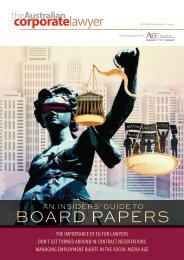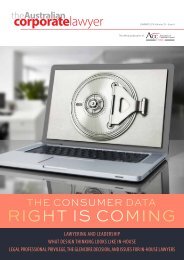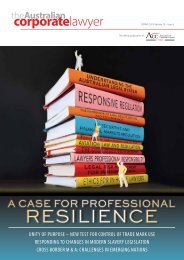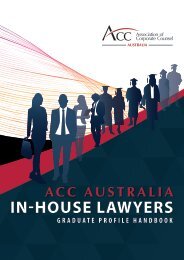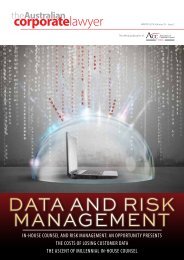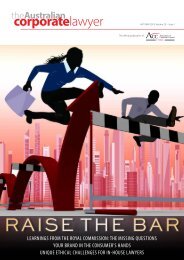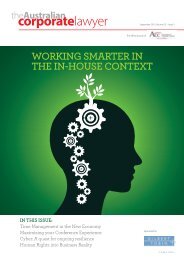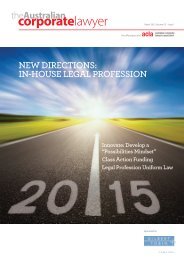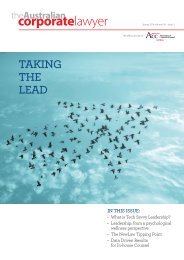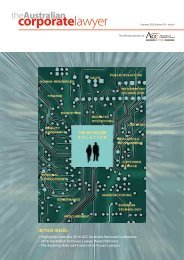Australian Corporate Lawyer - Summer 2018
Australian Corporate Lawyer is the official publication of the Association of Corporate Counsel (ACC) Australia. The Summer 2018 issue focuses on technology and features a range of articles covering topics including: The opportunity for legal innovation; digitalisation, technology and innovation are changing in-house legal teams; and six steps to overcome resistance to technology change.
Australian Corporate Lawyer is the official publication of the Association of Corporate Counsel (ACC) Australia. The Summer 2018 issue focuses on technology and features a range of articles covering topics including: The opportunity for legal innovation; digitalisation, technology and innovation are changing in-house legal teams; and six steps to overcome resistance to technology change.
You also want an ePaper? Increase the reach of your titles
YUMPU automatically turns print PDFs into web optimized ePapers that Google loves.
the<strong>Australian</strong>corporatelawyer<br />
acla.acc.com<br />
DEVELOPMENTS IN LITIGATION<br />
TECHNOLOGY: EARLY SLEUTHING<br />
AND SCOPING<br />
Emerging developments in litigation technology and increasingly affordable<br />
analytics software can save legal departments time and money through an<br />
enhanced and accelerated understanding of the critical issues involved.<br />
In litigation, the side that gets the earliest and best understanding of<br />
the underlying facts and how the evidence supports or undercuts<br />
key witnesses, has a distinct strategic advantage. Fortunately, several<br />
trends are converging that make early case sleuthing and scoping more<br />
affordable and feasible than ever, for cases of all sizes:<br />
••<br />
Cloud storage is increasingly inexpensive and highly elastic. Large<br />
volumes can be processed on demand for literally pennies per<br />
gigabyte without infrastructure investment. Geo-specific cloud storage<br />
can keep data in-country, avoiding many GDPR problems.<br />
••<br />
Secure bandwidth has increased. Large sets of data can be moved<br />
quickly, securely and economically without physically shipping<br />
computer media.<br />
••<br />
Analytics software is becoming more ubiquitous. Corporations<br />
don’t have to load email and documents onto expensive final review<br />
platforms to have comparable functionality, e.g., predictive coding,<br />
concept wheels, email threading, deduping, text search.<br />
••<br />
Project-based virtual teams can come together just for the life of a<br />
project and include the expertise needed for any part of the project,<br />
e.g., database discovery or dealing with legacy applications. There is no<br />
need for large, ongoing headcounts.<br />
••<br />
Screen-sharing applications permit quick, spontaneous meetings<br />
and information exchanges. Litigation teams can be assembled<br />
globally and be much nimbler than only face-to-face meetings.<br />
••<br />
Pricing models have shifted from the old per-gigabyte or perdocument<br />
models. Experts now provide technology at either no<br />
additional cost or may bill for direct out-of-pocket cost for things like<br />
Amazon Web Services hosting or processing fees—minor expenses<br />
compared to final review platforms.<br />
These trends offer opportunities and solutions with distinct advantages<br />
over traditional methods of document review and predictive analytics.<br />
Early sleuthing and scoping<br />
Being able to collect, process and analyse email and electronic documents<br />
for little or no cost allows lawyers to understand what they have when<br />
deciding whether to settle or to negotiate on a preliminary scope for<br />
e-discovery. It also provides metrics to use in such negotiations.<br />
The truth is that if corporations use people who understand robust software,<br />
they can find whatever they need in just about any collection of documents,<br />
without a lot of cost and heartache. With the early investigation and scoping<br />
approach to e-discovery, outside counsel will be reading only relevant<br />
documents for intelligence and understanding, not just to make ‘in’ or ‘out’<br />
relevancy decisions or apply ‘confidential’ or ‘privileged’ tags to documents.<br />
discovery with the government or adversary, but also to inform you about<br />
who else really should be included as a custodian, based on the electronic<br />
evidence, not just supposition.<br />
After the work is done and the relevant documents are produced, any<br />
questions by opposing counsel as to completeness can be quickly resolved<br />
with a screen-share meeting with the lawyer who did the work, explaining<br />
the strategy and process for locating the documents. As any trial lawyer will<br />
say, the story of how the process worked is much more defensible than any<br />
measure of recall or precision through sampling, which will always be less<br />
than 100 per cent.<br />
Examples<br />
Here are some scenarios of how this new approach to technology-assisted<br />
awareness and processing can work.<br />
Product liability—eye and skin irritation. You have a potential product<br />
liability situation where employees of a customer have complained about<br />
itching eyes and skin from using the product at workbenches. Work Health<br />
and Safety investigators have requested documents and your client is<br />
worried about lawsuits. Under traditional ‘wait and see’ litigation discovery<br />
practices, discovery would have been put off because of the expense.<br />
With today’s technology offerings and project-based teaming, you can<br />
collect email and documents from your key employees without incurring<br />
costs, and process them into a document repository with investigative<br />
analytics and sophisticated search. This could cost as little as $20 per<br />
gigabyte, per month, with no additional fees for generating TIFFs, deduping,<br />
threading emails, or persistent highlighting of keywords and productions.<br />
<strong>Lawyer</strong>s skilled in using the platform’s software would investigate the<br />
documents collected and provide you and your client with a ‘who’s who’ or<br />
‘key players’ list, a chronology and meaningful intelligence regarding what<br />
your client knew, or should have known, about itching eyes and skin from<br />
use of its products in a matter of days. Total professional fees at $200 per<br />
hour are less than $5,000.<br />
Additional scenarios<br />
Here are additional scenarios and how they might pan out using a strategic<br />
approach that leverages lawyers skilled in using state-of-the-art document<br />
analytics software in an elastic cloud computing environment:<br />
the departed employee’s email can be quickly organised and managed<br />
as needed, for less than $2,000 in most cases.<br />
••<br />
Subpoena responses. Responses to information and document<br />
subpoenas that might have run up costs and fees over $20,000 can now<br />
be responded to for less than $5,000, including processing, hosting,<br />
review, tagging and production.<br />
Potential Technology Assisted Review (TAR) tunnel vision<br />
An overemphasis on TAR (a.k.a. predictive coding) to solve discovery-related<br />
issues can lead to two types of tunnel vision:<br />
••<br />
Tool focus. Focusing on the predictive coding type of TAR (classifying<br />
sets of documents based on classifying a subset of them) can lead<br />
to ignoring other proven tools like concept clustering, domain name<br />
analysis, social network analysis or advanced search techniques.<br />
••<br />
Overemphasis on review. Focusing on the review phase can cause<br />
lawyers to overlook opportunities for both analysis and understanding<br />
much earlier in the litigation process. Document review may not take<br />
place for many months, if not years, after the suit is initiated, and that is<br />
simply too late to go hands-on with the documents. To the extent that<br />
corporations find TAR to be a useful way to gain understanding, they<br />
should consider using it before documents are placed in a final review<br />
platform. They can also use it to evaluate not just outgoing productions<br />
but productions from other parties as well.<br />
Conclusion<br />
Scoping the extent and validity of litigation claims provides huge strategic<br />
advantages in knowledge and reduces cost to the great benefit of the<br />
corporation. Best of all, it is affordable and practical.<br />
E-DISCOVERY PROFICIENCY QUIZ<br />
BASIC E-DISCOVERY COST CONTROL<br />
Here are some basic things that can be done to greatly lower costs<br />
without compromising quality.<br />
••<br />
DeNIST. As soon as possible, identify and exclude files that are<br />
created by and obtained from software providers as part of their<br />
software installations and updates. There is no evidentiary value<br />
in these files. The National Institute of Standards and Technology<br />
maintains a Software Reference Library that lists these files and<br />
their hash values that can be used to identify them.<br />
••<br />
DeDupe. Don’t have multiple instances of the same files<br />
repeatedly reviewed by different people. It’s wasteful and you risk<br />
inconsistent production decisions.<br />
••<br />
Thread emails. Emails and attachments that are part of the same<br />
email conversation or thread must be tethered together so that<br />
they are read together by one person. This provides the overall<br />
context of the whole conversation and avoids inconsistent coding<br />
or designations.<br />
••<br />
Be transparent early. If sweeping discovery just doesn’t make<br />
sense, get on the phone with opposing counsel and say what<br />
you’re planning to do. Use screen-share software to show<br />
examples of what you’re talking about.<br />
••<br />
Get a divorce from per gigabyte pricing. Just as there is<br />
growing recognition that companies are better served by flat<br />
billing as opposed to per gigabyte pricing, e-discovery should be<br />
purchased on a largely flat-fee basis.<br />
••<br />
Use benchmarks. Participate in ACC and other forums to<br />
exchange information about what recurring tasks should cost. Use<br />
that information in negotiating price.<br />
<strong>Lawyer</strong>s who can’t make full hands-on use of the panoply of tools available to analyse electronic discovery are like dentists who can’t personally use drills.<br />
They lose the ability to interact with the data and quickly gain insights from it. Here are some basic tasks that lead investigators or attorneys should be<br />
adept at handling:<br />
Lead attorney/investigator<br />
Each of the following tasks, other than the keyword testing, should take less than 10 minutes.<br />
••<br />
Claim evaluation. You receive notice of a claim. By identifying principal<br />
players in the matter and doing a preliminary collection and processing<br />
of their email, you can quickly get a preview of how the case will play<br />
Communication frequency over time. Present a frequency analysis<br />
Because early scoping is affordable, attorneys can do this as soon as<br />
out. The costs to collect and ingest the email for a few of the individuals<br />
In litigation involving key dates, a spike or gap in communication patterns can be indicative of<br />
of the number of emails a specified person has sent or received<br />
the demand letter arrives. They can know before the case is filed what<br />
involved and to find out what happened for many cases, is less than<br />
underlying behaviour.<br />
emails within a given period.<br />
happened, who said what to whom, and whether to fight or settle. For every $1,500. As noted above, some consultants using Amazon Web Services<br />
pleading and subpoena, in-house counsel can quickly and inexpensively<br />
do not charge for collecting or processing data, instead charging hourly<br />
Cloud storage providers like DropBox, Google Drive, Cloud Drive, OneDrive, OneBox can be used to<br />
scope the task at hand by collecting the email for two or three highly<br />
for technical skills in using the software and finding the meaningful<br />
Private cloud storage. Find all documents mentioning online data store data off corporate networks. Identifying where those terms appear in a data collection can be<br />
relevant custodians and quickly see with whom they discussed the topics<br />
emails quickly (in some cases within a few hours).<br />
storage domains used for storing or exchanging data.<br />
a way of identifying potentially additional data sources. The person doing the searching should be<br />
at issue. This information can be used to not only negotiate the scope of ••<br />
Key employee departures. A key employee suddenly leaves. Collecting<br />
able to identify these domains/product names without being prompted or informed.<br />
and processing their email can be done for no cost and once it is in a<br />
False positive keyword testing. Conduct keyword analysis to<br />
Every data set is different, and ‘dirty’ search terms that unintentionally retrieve false positives can<br />
cloud-based repository, used by someone skilled in its search features,<br />
identify search terms that retrieve false positives.<br />
inflate costs enormously.<br />
30 | VOLUME 28, ISSUE 4 – SUMMER <strong>2018</strong> VOLUME 28, ISSUE 4 – SUMMER <strong>2018</strong> | 31<br />
Task<br />
Domain-specific usernames. List all usernames associated with<br />
a specified domain name and the number of emails to/from each<br />
user.<br />
‘Private’ email addresses. Identify all usernames associated with<br />
‘private’ email accounts, i.e., non-corporate email accounts.<br />
List name labels. Identify all the name labels associated with a<br />
given email address, e.g., the name labels associated with jsmith@<br />
enron.com might be ‘John Smith’, ‘J. Smith’, ‘Jack’ or ‘JS’.<br />
Recipient domains. Identify all domain names that a specified<br />
person has sent emails to, or all emails between certain individuals<br />
and/or organisations.<br />
Significance<br />
This task is critical for obtaining a basic understanding of who the key players are and what the<br />
relationships are among them.<br />
Private emails are sometimes used to circumvent monitoring of corporate accounts. E-discovery<br />
practitioners should be able to identify the leading ‘private’ email providers without being told, e.g.,<br />
Gmail.com, Hotmail.com, Yahoo.com, Comcast.com and Verizon.net.<br />
Name labels are added by people who create contacts in contact lists. There can be as many name<br />
labels as there are people who have a given email address as a contact. Listing name labels helps<br />
identify nicknames or alternate forms of names that sometimes appear without the email address<br />
or domain for subsequent analysis.<br />
Without the ability to see organisations or people with whom certain individuals of interest have<br />
been communicating, it’s hard to see overall communication patterns.



